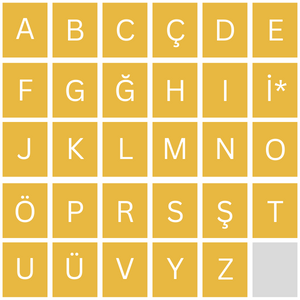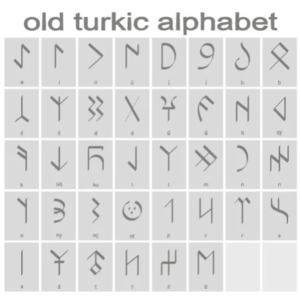Learning how to pronounce the letters in the Turkish alphabet (Turkish orthography) is one of the first and the most important steps you take.
Learning new words and bringing them together to make meaningful sentences is a lot easier once you have mastered the spelling and writing of the Turkish alphabet’s letters correctly.
First of all, if you master the Turkish alphabet early enough, you’ll be able to distinguish Turkish words and sounds. This will directly increase your comprehension.
A big mistake that the learners often make is to learn letter pronunciations wrong. This causes many problems and is not easy to fix later.
So, make sure that you are learning the pronunciation of each letter correctly.
This is an important and nontrivial step as there are distinct sounds that don’t exist in other alphabets. Let’s begin with the very basics.
How do you say ‘letter’ in Turkish?
- Harf – en. Letter
- Türk alfabesi or Türk abecesi – en. Turkish alphabet
The Turkish alphabet consists of 29 letters. It follows the order of the Latin alphabet with some additions. The English alphabet does not have the six of the 29 letters (Ü, İ, Ö, Ç, Ğ, Ş) in the Turkish alphabet. The Turkish Alphabet, conversely, does not have the three letters (Q, X, W) that are present in the English alphabet
Unlike French or English, the Turkish alphabet is phonetic. This means that each letter has one sound, and every one of them is pronounced.
While each letter is pronounced, two or more of them are not combined to make a new sound.
This makes your life easier when you are trying to read a word in Turkish!
Alphabet – Lower and Uppercase letters in the Turkish Language.
Küçük harfli kelimeler
Lowercase letters
Büyük harfli keliemeler
Uppercase letters
This list shows you the Turkish alphabet pronunciations. Try to exercise.
Turkish Alphabet Letters
| Audio | Turkish Letters | Pronunciation | More Examples starting with the letter |
| A – Ağır (en. heavy) | as in father | Aralık, Aslı, Araba | |
| B – Baba (en. father) | as in below | Bilim, Bilezik, Boğaz | |
| C – Cam (en. glass) | as in jar | Cuma, Cadı, Cevap | |
| Ç – Çaçaron (en. chatty, chatterbox) | as in challange | Çilek, Çiğdem, Çabuk | |
| D – Didim (A small town on the Aegean coast) | as in dark | Defter, Düzgün, Düzenli | |
| E – Ekmek (en. bread) | as in bed | Elma, Erik, Elbise | |
| F – Fırat (en. Euphrates, a river) | as in friend | Filiz, Fındık, Fırsat | |
| G – Göl (en. lake) | as in grind | Garip, Güz, Güzel | |
| No word starting with Ğ (soft g) | Ğ – Yumuşak G – soft g | this letter lengthens the preceding vowel | |
| H – Hayat (en. life) | as in has | Hırs, Hazır, Huzur | |
| I – Irmak (en. river) | as in open | Islık, Ispanak, Istakoz | |
| İ – İndirim (en. discount) | as in meet | İlgi, İstek, İzdüşüm | |
| J – Jandarma (en. gendarme) | as in measure | Jale, Jelibon, Jeton | |
| K – Kekeme (en. shutterer) | as in cop | Kış, Kız, Kalabalık | |
| L – Lale (en. tulip) | as in length | Laf, Lüzumsuz, Lüfer | |
| M – Mama (en. baby food) | as in measure | Muz, Memleket, Maymun | |
| N – Nene (en. grandmother) | as in nice | Nar, Nasıl, Nazlı | |
| O – Okul (en. school) | as in pore | Ocak, Olumlu, Orangutan | |
| Ö – Ömür (en. life) | German ö | Örümcek, Ölümsüz, Özgürlük | |
| P – Peder (en. father, reverand) | as in piece | Pırasa, Pınar, Pasta | |
| R – Rüya (en. dream) | as in rice | Rezil, Rahat, Ruh | |
| S – Simit (en. Turkish bagel) | as in sick | Sarımsak, Sıcak, Salıncak | |
| Ş – Şaşı (en. crosseyed) | as in shade | Şubat, Şık, Şırıltı | |
| T – Taksit (en. installment) | as in tip | Tatlı, Tarak, Tutumlu | |
| U – Uzuv (en. limb) | as in loo | Uzun, Usta, Uzak | |
| Ü – Ürdün (en. Jordan) | as in new | Üzüm, Üst, Ümit | |
| V – Veli (en. guardian) | as in vertical | Varlık, Vatan, Vasıfsız | |
| Y – Yağmur (en. rain) | as in yes | Yelek, Yatak, Yasak | |
| Z – Zemzem (en. zam-zam, holy water for muslims) | as in zodiac | Zürafa, Zeytin, Zaman |



Since Turkish does not have diphthongs, it is easy to pronounce letters correctly. Every letter has one distinct sound which is pronounced separately from the neighboring letters. None of the neighboring letters affect each other!
Turkish Alphabet – Lower and Upper Case


Special Turkish Letters
ı (lower case) – i without dot: it’s a back vowel: I (upper case) – e.g. Kasım
İ (upper case) – I with dot: it’s a front vowel – e.g. İstanbul
Turkish Letters: Classification in the Turkish Alphabet
Letters Specific to Turkish
Ç (ç): Reads like “ch” in the word “chair.” For example, çocuk (child).
Ğ (ğ): This letter is sometimes called a “soft g” since it lengthens the vowel that comes before it. There isn’t a direct English counterpart for it. For example, yağmur (rain).
Ş (ş): Pronounced as “sh” in “shoe.” Example: şal (shawl).
I (ı): A vowel sound, not dotted like the English “i,” that falls somewhere between the “i” in “cousin” and the “u” in “supply.” For example, ısı (temperature).
İ (i): The dotted form of the Turkish “ı,” pronounced like the “ee” in “see.” For example, consider izin (permission).
Ö (ö): While it sounds like the “i” in “bird” or the “eu” in “neuron” in some English accents. For example, öğrenci, a pupil.
Ü (ü): Like the French “u” or the “ue” in “blue.” For example, gümüş (silver).
These classification will be meaningful when learning vowel harmony rules. At this point, it’s okay if you are just familiar with this classification.
Vowels of the Turkish Alphabet
Vowel letters are classified as follows according to the condition of the tongue, the condition of the lips, and the opening of the mouth:
- According to the condition of the tongue:
Back vowels: a, ı, o, u
Front vowels: e, i, ö, ü
- According to the condition of the lips:
Unrounded vowels: a, e, i, i
Rounded vowels: o, ö, u, ü
- According to mouth opening:
Wide vowels: a, e, o, ö
Narrow vowels: ı, i, u, ü
Consonants of the Turkish Alphabet
Consonants are divided into two according to whether the vocal cords vibrate or not:
- Tonal (soft) consonants: b, c, d, g, ğ, j, l, m, n, r, v, y, z.
- Toneless (Strong) consonants: ç, f, h, k, p, s, ş, t. (PaŞa ÇoK HaSTa)*
*This classification will be meaningful when learning the consonant alternation.
Turkish Alphabet: 8 Essential Things That You Should Know
1. The pronunciation of ğ (soft g). Do you pronounce the soft g in Turkish?
Let’s give an example.
The Turkish word “Yağmur” (which is also a female name) means “rain” in English. It is pronounced as “yaaa-mhur” So, the letter “ğ” lengthened the letter before itself, which is “a” in our example. Don’t confuse the ğ (the soft g) with its sibling “g”.
More examples: e.g. “Kağnı” (eng. tumbrel) may be heard as “kaanı” or “dimağ” (eng. mind, brain) is often heard as “dimaa”
2. In Turkish, the dotted letter i is also written in capital letters: İ. Similarly, the capital letter I without a dot is not written when written in lowercase: i.
3. Letters with the circumflex accent are pronounced longer.
The circumflex is a diacritic sign usually written above a letter.In Turkish, it is called “şapka” which means exactly “hat”. Most of the Indo-European alphabets don’t have it. Read more about the circumflex accent.
Hala
aunt
Hâlâ
still
4. At the end of the letter, intervocalic k is transformed into ğ if attached another vowel. Alternation of consonants (synonym) is covered in detail in the consonant mutation/alternation page.
Kapak
lid
Kapak+ı < kapağı
Kapağı verebilir misin?
Can you give me the lid?
5. L has two different sounds in Turkish. One is l as in “layer”, the other as in “cool”.
6. In some dialects in Anatolia, k is pronounced as g. “Kapı” (eng. door) can be heard as “gapı” However, this is very informal and not recommended.
7. “Y” is a little bit different than English “y”. For example, how you pronounce the word “copia” in Spanish is very similar to Turkish “kopya”.
8. Most of the French borrowing starting with s take the prefix –i in Modern Turkish.
- Station > istasyon
- Statistique > istatistik
9. Loanwords that have c are written with k.
- Category > kategori
- Coiffeur > kuaför
- Complex > kompleks
Do not forget that there is no “x” in the Turkish alphabet, instead “ks” is used.
Turkish Letters Song
Some History About the Turkish Language Alphabet

In the past, Turks have used a variety of scripts. Some of the ancient alphabets that the Turkish have utilized include Göktürk (Orhun), Uygur, Arabic, and Kiril.
Arabic script, which has an alphabet with a lot of consonants and limited number of vowels, was utilized during the Ottoman era. (The Turkish language, on the other hand, has eight vowels.)
The Latin alphabet was adopted in 1928, not long after the Ottoman Empire fell.
Turks utilized the Göktürk (Orhun) alphabet up until the eleventh century before switching to the Arabic script. The Turkish language’s sounds are thought to be best represented by this old alphabet. (Words were written in a manner like the Arabic alphabet with the Göktürk alphabet, from right to left.)
Old Turkish steles (Orkhon inscriptions), for instance, were written in the 8th century using the Göktürk alphabet. These steles mention the extent of the Turkish empire.
If you want to learn more details, check out the page (Ses, Harf ve Alfabe) of Turkish Language Society (T.D.K. – Türk Dil Kurumu).
FAQs on the Alphabet
- How many letters are in the Turkish alphabet?
- How many vowels are in the Turkish alphabet?
- How many consonants are in the Turkish alphabet?
- What are the 3 letters that do not exist in the Turkish alphabet?
- What are the 6 letters in the Turkish Alphabet that do not exist in the English Alphabet?
- Is Turkish read from left to right?
Advanced Questions about the Turkish Language Alphabet:
- What are the toneless consonants in the Turkish alphabet?
- What are the tonal consonants in the Turkish alphabet?
- What are the back vowels in the Turkish alphabet?
- What are the front vowels in the Turkish alphabet?



